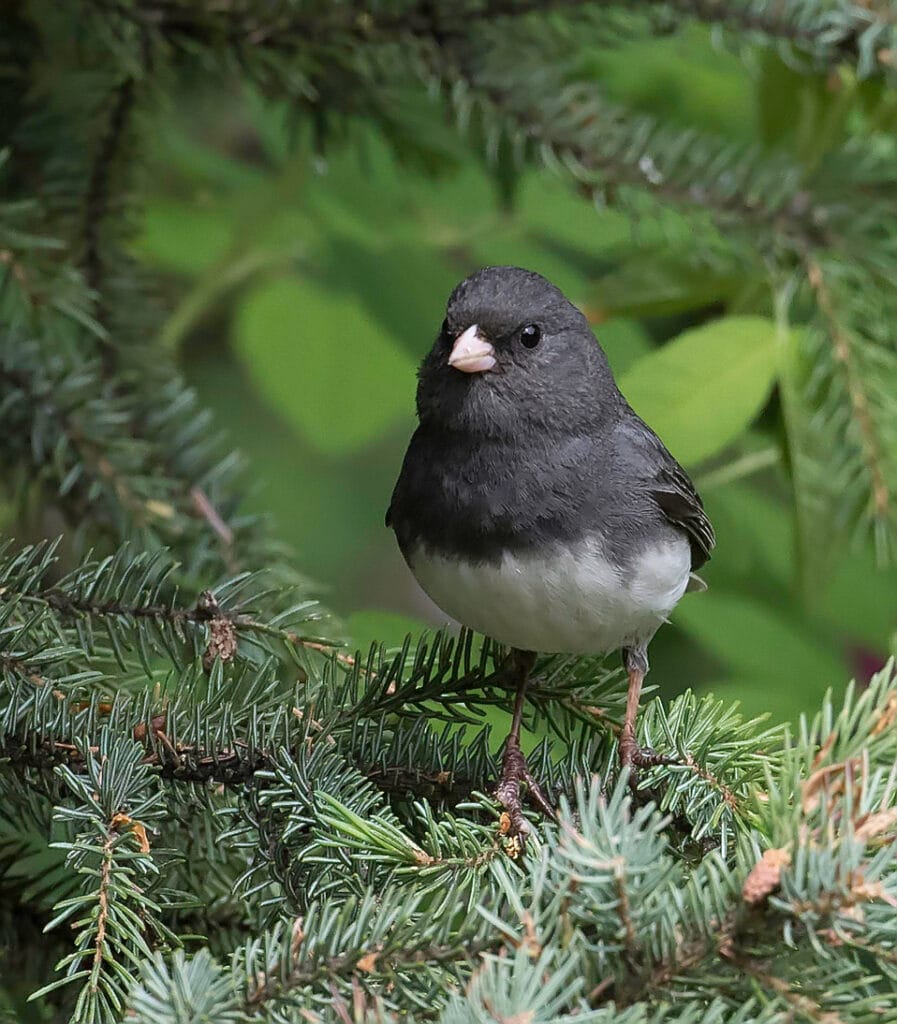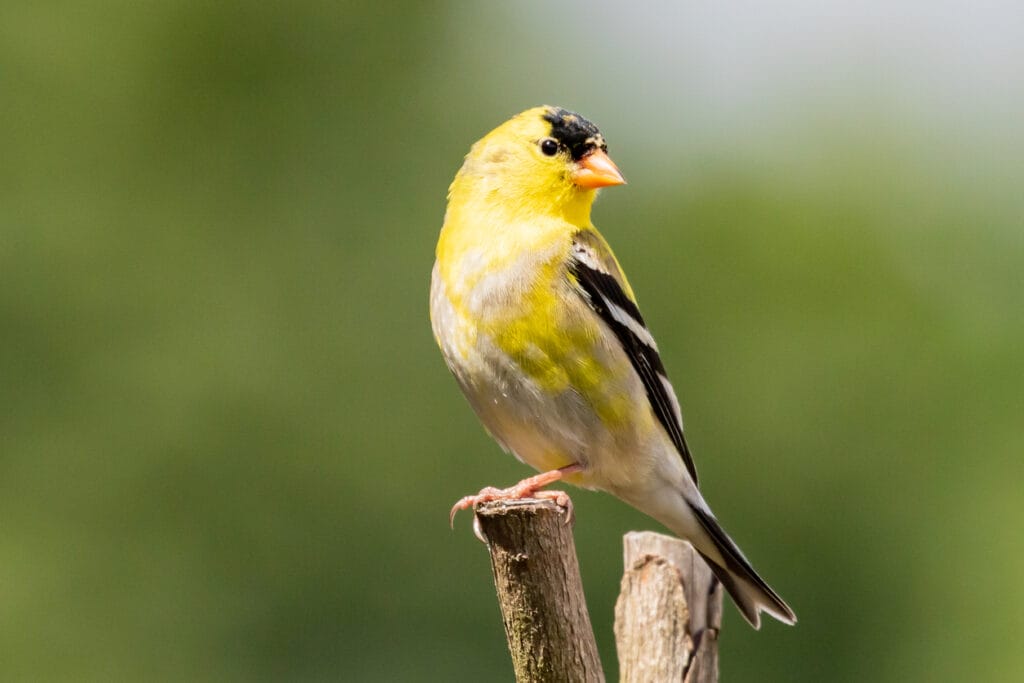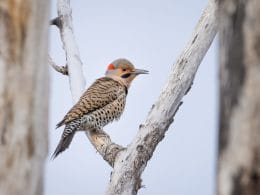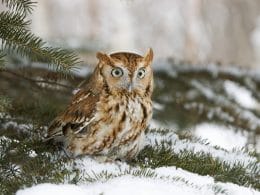Massachusetts is the 8th most forested state in the US. With approximately 3.1 million acres of forest land, trees cover about 60.4% of the state’s land area. Therefore, it’s no surprise that it’s home to a wide variety of wildlife species.
According to the Massachusetts Avian Records Committee (MARC), there are just over 500 recorded bird species in the state. Although some rarely leave Massachusetts’s cozy forests, most appear close to home.
This article lists some of the most stunning backyard birds of Massachusetts, along with tips on how to attract them to your yard. Let’s dive right in!
1. Black-Capped Chickadee

- Scientific name: Poecile atricapillus
- Length: 4.7–5.9 in.
- Wingspan: 6.3–8.3 in.
- Weight: 0.3–0.5 oz.
Black-capped Chickadees are the most common backyard birds in Massachusetts, appearing at a frequency of 45-48%. It’s also Massachusetts’s official state bird. They’re found year-round throughout the state, but they mostly visit backyards during fall and winter to forage for snacks in suets and bird feeders.
These small birds have a simple, distinctive coloring that makes them easy to identify: soft gray backs, long gray wings and tails, and white outer feathers. They also have a black ‘bib’ from the base of their throat, and a large, black cap across their head—hence the name, “Black-capped Chickadee.”
Author Note: Black-capped Chickadees feel most comfortable in areas with dense vegetation, so they often live in deciduous and mixed forests.
To attract these beautiful birds to your backyard, fill your seeder with hulled sunflower seeds, black oil sunflower seeds, and berries. They love peanut butter and suet, too!
2. Blue Jay

- Scientific Name: Cyanocitta cristata
- Length: 8.6–11.8 in.
- Wingspan: 13.3–16.9 in.
- Weight: 2.5–3.5 oz.
Blue Jays are the second-most common backyard birds of Massachusetts, appearing at a frequency of 43-47%. They’re a year-round resident of the state and regularly visit backyards feeders throughout most of the summer and early fall.
Thanks to their bright blue coloring, Blue Jays can be spotted from miles away. They have large blue crests on top of their heads and mostly blue feathers along their backs.
Blue Jays are quite vivacious. They’re vocal and active, with their loud Jay! Jay! calls echoing across parks and forest edges. For this reason, they’re among the first to alert other birds of predators in the area.
When it comes to food, Blue Jays birds aren’t picky. They love anything and everything, from sunflower seeds to suet. They adore shelled peanuts the most, though, so make sure you have plenty of them in your feeders to lure them in!
3. American Robin

- Scientific name: Turdus migratorius
- Length: 7.9-11.0 in
- Wingspan: 12.2-15.8 in
- Weight: 2.7-3.0 oz
American Robins are extremely common in Massachusetts’s backyards. Although they don’t often visit bird feeders, you’ll see them hopping around the grass looking for worms, insects, and other invertebrates.
These birds have red bellies, yellow beaks, and brown or dark gray backs, wings, and tails. They also have a distinct, fragmented eye line that’s unique to their species. Female American Robins aren’t as vibrant as male American Robins, but they’re just as stunning.
Top Tip: In Massachusetts, American Robins are found just about anywhere. You’ll see them in forests, farms, parks, fields, and golf courses. During winter, you’ll find them hopping around in the snow.
American Robins aren’t fond of seeds, but they adore mealworms and chopped fruit. They also love playing in birdbaths, so make sure you have one or two in your backyard!
4. Northern Cardinal

- Scientific Name: Cardinalis cardinalis
- Length: 8.3–9.1 in.
- Wingspan: 8.9–12.2 in.
- Weight: 1.5–1.7 oz.
Found in Massachusetts year-round, Northern Cardinals are among the most common and recognizable birds in the state.
Male Northern Cardinals are almost entirely bright red in color, with red cone-shaped bills and red bodies. Female Northern Cardinals aren’t as distinctive with their soft brown plumage.
Although you’ll find a sizable number of these birds in forest edges, they’re mostly seen in urban settings. You’ll find them in parks, phone lines, fences, and, of course, backyards.
Northern Cardinals eat almost anything, from sunflower seeds to good ol’ cracked corn. They’ll visit feeders filled with suet, berries, seeds, insects, and various fruits like raisins, grapes, and apple slices.
5. Tufted Titmouse

- Scientific name: Baeolophus bicolor
- Length: 5.5-6.3 in.
- Wingspan: 7.9-10.2 in.
- Weight: 0.6-0.9 oz.
Aside from the orange-yellow wash on their underbellies, Tufted Titmice are almost entirely blue-gray in color. Like Northern Cardinals, these birds have a small mohawk-like crest on top of their heads.
Tufted Titmice are social creatures and are often seen flocking with nuthatches, woodpeckers, and chickadees.
However, they’re quite assertive over smaller birds. They’d sometimes nudge other birds off the birdfeeder to get better access to food. They’d also ‘scold’ other birds over any transgression, real or imagined, big or small. For this reason, bird lovers often call them “imps of the woods.”
Author Note: These birds appear year-round in Massachusetts. To increase your chance of sighting these birds, fill your feeders with mixed seed blends, black sunflower seeds, and chunky peanut butter.
6. Eastern Bluebirds

- Scientific Name: Sialia sialis
- Length: 6.3–8.3 in.
- Wingspan: 9.8–12.6 in.
- Weight: 0.95–1.20 oz.
Eastern Bluebirds were once rare in Massachusetts, especially during winter seasons. However, their numbers have increased substantially during the last decade or so. Today, Eastern Bluebirds are found in the state year-round.
These gorgeous birds are known for their tri-colored plumage. They have blue backs, reddish-orange chests, and white bellies. Females share the same coloring except not as striking.
Eastern Bluebirds mostly eat insects and soft fruit. Although they eat seeds from time to time, they’re not their food of choice.
So, to attract these tri-colored birds in your backyard, fill a feeder with mealworms and various other insects. They also enjoy suet dough and chopped fruit.
7. Mourning Dove

- Scientific name: Zenaida macroura
- Length: 9.1–13.4 in.
- Wingspan: 17.7 in.
- Weight: 3.0–6.0 oz.
Named for their mournful, owl-like cooing, Mourning Doves are plump-bodied songbirds with large wings, long tails, and small heads. The color of their plumage differs from region to region, but they’re typically dressed in shades of gray or soft brown.
Mourning Doves are urbanized birds. Due to this, they’re generally unbothered by humans. They’re frequently seen looking for tasty snacks in parks, farms, city rooftops, and backyards.
To temp Mourning Doves to your backyard, fill your feeders with black sunflower seeds, cracked corn, and white proso millet.
8. Dark-eyed Junco

- Scientific name: Junco hyemalis
- Length: 5.5–6.3 in
- Wingspan: 7.1–9.8 in
- Weight: 0.6–1.1 oz
Dark-eyed Juncos appear in Massachusetts’s backyards during fall and winter at a frequency of 15-17%.
Like Mourning Doves, the coloring of Dark-eyed Juncos differs from state to state. In Massachusetts, they’re dressed in steely gray or dark brown plumage. Their breasts and underbellies are a mix of white and gray.
In warmer seasons, Dark-eyed Juncos spend most of their time in coniferous or mixed-coniferous forests. But as winter approaches, they move to forest edges, parks, and backyards.
Dark-eyed Juncos adore black oil sunflower seeds, white proso millet, and cracked corn.
9. American Goldfinch

- Scientific Name: Spinus tristis
- Length: 4.3–5.5 in.
- Wingspan: 7.5–8.7 in.
- Weight: 0.39–0.71 oz.
American Goldfinches are among the most brightly colored birds in Massachusetts. They have bright yellow backs, yellow bellies, and black wings with white wing bars, so they’re quite easy to spot.
These tiny birds are fond of flood-prone areas with dense vegetation and locations with plenty of thistle and milkweed plants.
American Goldfinches visit backyard feeders year-round for sunflower seeds and nuts. However, they’re especially active during winter and may visit your feeder in large flocks.
Unlike most other finches, American Goldfinches are vegetarians. They dislike insects and worms and would only ever eat them by accident. In the wild, they mostly feed on buds, seeds, maple sap, and the bark of young twigs.
Top Tip: To attract these lively birds in your yard, fill your feeder with the seeds of goldenrods, dandelions, and asters. They also adore black oil sunflower seeds and Nyjer thistle.
10. Downy Woodpecker

- Scientific name: Picoides pubescens
- Length: 5.5–6.7 in
- Wingspan: 9.8–11.8 in
- Weight: 0.7–1.0 oz
Downy Woodpeckers are the smallest North American Woodpeckers in Massachusetts. Thanks to their distinctive coloring, they’re quite easy to recognize. They have black wings with white checkered-like spots, black and white striped heads with red crests, and all-white underbodies.
They closely resemble Hairy Woodpeckers, except they’re much smaller.
Downy Woodpeckers visit backyard feeders throughout the year, but they’re especially common during winter. They love shelled peanuts, sunflower seeds, millet, and suet.
11. American Tree Sparrow

- Scientific name: Spizelloides arborea
- Length: 5.5 in
- Wingspan: 9.4 in
- Weight: 0.5–1.0 oz
American Tree Sparrows resemble overgrown chipping sparrows, which is why they’re often dubbed as “winter chippies.”
Although they don’t breed in Massachusetts, American Tree Sparrows are among the most common migrants and winter residents of the state. When winter hits, they eagerly flock to backyard feeders and weedy fields.
American Tree Sparrows have large, plump bodies and long tails, making them appear larger than other sparrows. They have smooth gray breasts and streaked brown backs, giving them an overall reddish-brown and gray appearance.
Despite their namesake, American Tree Sparrows do much of their feeding on the ground. So, if you want to attract these birds to your backyard, scatter seeds and dried insects on the ground around the feeder. They also love berries, so make sure to have a plate ready for when they visit.
12. Baltimore Oriole

- Scientific name: Icterus galbula
- Length: 6.7-7.5 in.
- Wingspan: 9.1-11.8 in.
- Weight: 1.1-1.4 oz.
Baltimore Orioles visit Massachusetts in spring, summer, and early fall. These birds have black heads, black backs, and bright orange breasts and underbodies. They also have orange tails and rumps.
Like most birds, females are duller in comparison. Instead of fiery orange, they have grays in place of blacks, and yellowish wings, breasts, and underbodies.
Baltimore Orioles are frequent backyard visitors, but they prefer yards with tall trees the most. Since they love sweet things, lure them to your yard with jellies, oranges, bananas, and dark-colored berries and fruits. They also love nectar made with sugar water and flower pieces like buds.
13. Chimney Swift

- Scientific name: Chaetura pelagica
- Length: 4.7–5.9 in
- Wingspan: 11–12 in
- Weight: 0.60–1.06 oz
Compared to most birds on this list, Chimney Swifts look fairly unremarkable in the color department. They’re covered in dark brown plumage that fades to a lighter gray on the throat and chin. They have long wings, short tails, and wide (but small) beaks. To a regular passerby, they’re not worth a second glance.
With that said, Chimney Swifts are unique and beautiful in their own way. They’re best identified through their stubby, cylindrical bodies and quick, stiff wingbeats. For this reason, Chimney Swifts are often called “cigars with wings.”
As the name implies, Chimney Swifts are often found nesting in chimneys and other vertical structures, like air vents, wells, caves, and hollow trees. They mostly forage in rivers, lakes, forests, and fields, but they’re impartial to urban and suburban areas.
Chimney Swifts have a diet that consists of 95% insects. Since they prefer live insects, they won’t be tempted with dried mealworms and the like.
Top Tip: Instead of stocking up your feeders with dried crickets and mealworms, fill your feeder with live feeder insects.
Conclusion
There you have it; 13 of the most gorgeous backyard birds of Massachusetts! Although most of these birds appear year-round, some only visit in certain seasons, as observed with Dark-eyed Juncos and Eastern Bluebirds. So, always keep an eye out for new visitors throughout the year.
If you’d like to get a little more involved with the state’s birdlife, visit the Massachusetts Audubon Society, a nonprofit organization dedicated to protecting the state’s wildlife. From there, you can participate in workshops, birding doors, and field trips.
Happy birding!
FAQ
Massachusetts is home to a diverse range of bird species, including songbirds, waterfowl, shorebirds, and birds of prey. Some common bird species found in the state include American Goldfinches, Eastern Bluebirds, Northern Cardinals, and Tufted Titmice.
One of the most common small birds in Massachusetts is the American Goldfinch, a brightly colored finch with a distinctive yellow and black plumage.
A common grey bird in Massachusetts is the Tufted Titmouse and the Grey Catbird.
Some big birds found in Massachusetts include the Turkey Vulture, Bald Eagle, and Great Blue Heron. These birds of prey can be seen soaring over the state’s forests, fields, and wetlands.










